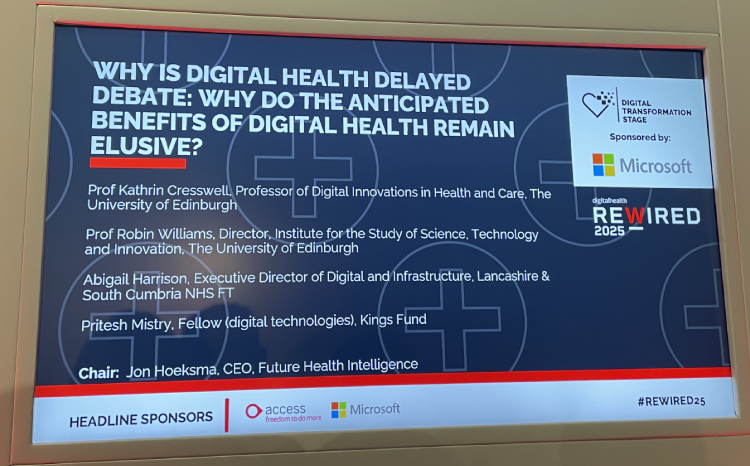Sussex Community aims to become digital leader as strategy is laid out
- 18 October 2022

Sussex Community NHS Foundation Trust (SCFT) has laid out its digital strategy delivery plan, with a main ambition of becoming a digital leader in the NHS. Diarmaid Crean, chief digital and technology officer at the trust, spoke exclusively to Digital Health News about the new strategy, the timing of it and the importance of gathering feedback from staff and patients.
SCFT’s digital strategy delivery plan focuses on seven areas: patient interactions and innovation, user experience, digital transformation and EPR optimisation work, sharing data, population health management, infrastructure and cyber resilience, and interoperability and systems.
The trust decided to write their strategy in a way that is different to how the NHS usually lays plans out, instead focusing more on what staff and patients have to say.
Diarmaid Crean, chief digital and technology officer at Sussex Community, who was named CIO of the Year at this year’s Digital Health Awards, said: “The way that we wrote our strategy was we tried to steer away from how the NHS and other big organisations have tended to do these things, which is to list out products or systems that you will implement.
“We took a user-centred approach and went back to our frontline staff and our patients and said, ‘what do you want’, and through that dialogue with them we ended up developing a strategy.”
SCFT’s digital strategy delivery plan, which makes up part of the trust’s dedicated digital transformation website, can be viewed online here. The plan is very much based off what staff and patients need to do their jobs better and receive better care.
It states that patients will have more control over their interactions with the trust and its clinicians will be able to remotely monitor patient observations to determine when a face-to-face consultation is required.
Some of the innovations listed that the trust plans to implement include current health wearable devices, diabetes Libra home testing kits, and an eConsent tool for immunisations.
Under digital transformation and EPR optimisation work, the strategy shows SCFT’s intent to improve EPR configuration to respond to staff frustrations, implement a patient portal, and begin a digital access training programme to support basic digital literacy.
The trust also want all staff to have the kit and training they need to do their job properly and therefore will introduce end user devices and smartphones, improve resilience and cyber security to ensure their data is safe and easy to access whether in SCFT offices or working remotely, and improve WiFi.
Crean said: “On the face of it our strategy looks like quite a simple thing, which is our staff want the right kit to be able to do their job and have the right training to know how to use the systems in front of them, or our patients want to be able to access their data in a way that helps them manage their care interactions with us in a certain way.
“We’ve defined a number of key statements in our strategy and one staff requirement could mean a whole range of different things they want and a whole range of things we need to make available to them.
“Behind each statement there’s a lot of activity triggered for us in terms of listening to those staff members and how they’re trying to do their jobs and then thinking how we can provision them to meet their needs, rather than a classical or technical approach which is to list software that we can buy and install and then say we we’ve reached a certain category X of being really great.”
The timing of the strategy and future plans
Releasing a digital strategy is always a big project for a trust and the timing of the release is a significant decision to make. For SCFT, it has been something in the making for a while and following the peak of the Covid-19 pandemic, 2022 was deemed the year for it to go live.
Crean said: “We’ve been working on it for a while, so we’ve always wanted to have a strategy. I’ve been in the role for three years and it’s my first role in the NHS, so there was a little bit of not wanting to rush into a strategy.
“I had to get my head around what’s happening in the organisation and then obviously we had Covid, so we all were very busy trying to make sure that we manage that. I was a digital leader of the vaccine programme and that was a significant focus for us as a group of people,” he added.
“So it felt like coming out of the pandemic at this stage, it was the right moment to boldly say ‘okay we’re going to go further, faster, higher now’ and go big.”
SCFT’s digital strategy is not one with a specific timeframe attached to it but one that will be regularly looked at and refreshed as the digital landscape evolves.
Crean said: “I’m wary of doing a strategy where we say ‘this is our five year strategy’ because in a digital space, the space in my world, it’s so fast paced and innovative that stating what you think the future is going to look like in five years is a bit of a foolhardy thing.
“I would rather we refreshed our strategy on a regular basis, so every year look at the things that we know our staff and patients want, check against the things we thought they told us before, how they’ve changed and then redouble our efforts to make sure we’re meeting their needs,” he explained.
“Our approach is to listen all the time, monitor the opportunities of technology and then bring those things together. It’s an evolving, never-ending strategy that will constantly move forwards to meet the needs of our staff and patients.”
The importance of staff and patient feedback
Without speaking to staff and patients, SCFT would not have known what things they need to do to raise the digital level of the trust and move closer to their ultimate ambition of becoming a digital leader in the NHS.
On the importance of gathering feedback from staff and patients, Crean said: “It was vital. We did wholescale, user-centred research for our end users across this organisation, so in-depth analysis by interviewing people at length and then also multiple surveys out to different groups of staff and patients that we kept running and captured as much data as we possibly could.
“All of that information we synthesised into a set of personas about our staff and understanding of our patients and that then led to us being able to get to a point where we had the strategy that we had.
“Without that intelligence from staff and patients, and that in-depth rich data that they provided us through that experience, we would not have the strategy that we have.”






1 Comments
Great to see this exciting strategy Diarmaid. Very much enjoying working with you and the team as we build on our excellent Sussex-wide digital and data capabilities to truly transform health and care, and address health inequalities across our system
Comments are closed.